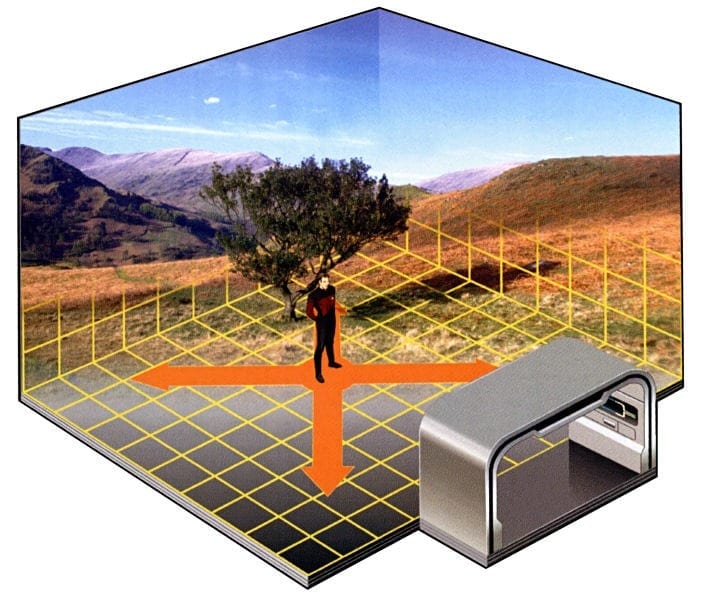
“Ten years ago, it seemed like a dream. Now, it feels within reach.”
Isaac Newton, Albert Einstein and Stephen Hawking are playing poker together.
No, this isn’t a bad physics joke. It’s a scene from “Star Trek: The Next Generation.” It takes place in a holodeck, a simulated-reality room in the fictional Star Trek universe. The three scientists — or at least computer-generated versions of them — have been transported to the 2300s to play cards with Lt. Cmdr. Data.
“I don’t even know why I’m here in the first place,” Newton says.
While the show is set in the future, some scientists and researchers say we could have something like holodecks by 2024. If you have enough money, you could even buy one today, though it would be crude compared to the holodecks on Star Trek.
This is all part of a quest by computer companies, Hollywood and video game makers to move entertainment closer to reality — or at least a computer-generated version of reality. Rather than simply watch movies, the thinking goes, we could become part of the story. We could see people and things moving around our living rooms. The actors could talk to us. Gamers who today slouch on the couch could step inside their games. They could pick up a computer-simulated bat in computer-simulated Yankee Stadium while a computer-simulated crowd roared around them.
“The holodeck is something we’ve been fixated on here for a number of years as a future target experience that would be truly immersive,” said Phil Rogers, a corporate fellow at Advanced Micro Devices, the computer chip maker. “Ten years ago, it seemed like a dream. Now, it feels within reach.”
At A.M.D.’s headquarters in Sunnyvale, Calif., Mr. Rogers and his team have built a version of a holodeck. It’s shaped like a dome and is covered with wall-to-wall projectors. The room uses surround sound, augmented reality and other technologies to recreate the real world.
“Eventually, wallpaper will become intelligent and we will paper over our entire living room with intelligent paper, surrounding and immersing ourselves with 3-D images,” said Michio Kaku, a theoretical physicist. “Much of this technology already exists, but in crude form.”
How would you walk through these virtual worlds without hitting your bedroom or office wall? The United States Army Research Laboratory has already solved that problem. It has created a floor called an “omnidirectional treadmill” that enables people to seemingly wander around a room while the floor moves and the person stays in place.
This all sounds fun. But it also sounds terrifying to some industries.
The Latest on: Holodeck
[google_news title=”” keyword=”Holodeck” num_posts=”10″ blurb_length=”0″ show_thumb=”left”]
via Google News
The Latest on: Holodeck
- Make 3D Scenes With A Holodeck-Like Voice Interfaceon April 29, 2024 at 8:30 am
The voice interface for the holodeck in Star Trek had users create objects by saying things like “create a table” and “now make it a metal table” and so forth, all with ...
- Star Trek: 10 Characters That Faked Their Way Into Starfleeton April 26, 2024 at 6:11 am
Starfleet without the 'fleet' seems like a bit of a misnomer or, as Seska herself would argue, a missed opportunity. Captain Janeway was rightly determined to get her ship home following Federation ...
- Shockingly, People Aren’t Interested In Paying $3,500 For Apple’s Wildly Overpriced Vision Pro VR Headseton April 26, 2024 at 5:49 am
Apple analyst Ming-Chi Kuo reported that the company had slashed its Vision Pro shipments to 400,000-450,000 units, with the market predicting 700,000–800,000 units or more. According to the report, ...
- Sony’s new TVs take Mini-LED to the max: Here’s what you should knowon April 19, 2024 at 1:00 pm
From backlots to TV backlights, soundstages to soundbars, Sony held a premiere for its 2024 BRAVIA lineup and we walked their red carpet.
- Is the Internet the Enemy of Progress?on April 19, 2024 at 10:25 am
But it’s 29 years old, written when the true internet era was still just a gleam in Al Gore’s eye. And as prophecies go, it’s pretty impressive — up there with Malcolm’s rather more famous prediction ...
- Best of Last Week—gravity free technology, recreating the Holodeck, why the moon is lopsidedon April 14, 2024 at 5:00 pm
And a team at the University of Pennsylvania recreated Star Trek's holodeck using ChatGPT and video game assets—called Holodeck, the system generates interactive virtual 3D environments. A team of ...
- A real Holodeck? Scientists recreate Star Trek technology with ChatGPTon April 12, 2024 at 9:14 am
The real-life Holodeck could eventually help to train robots in a virtual environment before they are deployed in the real world. In Star Trek: The Next Generation, Captain Picard and the crew of the ...
- Engineers Use ChatGPT, Video Game Assets to Recreate Star Trek's Holodeckon April 11, 2024 at 8:04 pm
In the sci-fi realm of "Star Trek: The Next Generation," the Holodeck stands as a pinnacle of interactive technology. Crew members can immerse themselves in lifelike 3D environments, ranging from ...
- Star Trek's Holodeck recreated using ChatGPT and video game assetson April 10, 2024 at 5:00 pm
Star Trek's Holodeck is no longer just science fiction. Using AI, engineers have created a tool that can generate 3D environments, prompted by everyday language. In Star Trek: The Next Generation ...
- Holodeck Arenaon April 6, 2024 at 3:21 pm
All the Latest Game Footage and Images from Holodeck Arena Compete for supremacy in this fast-paced cyberspace-RTS with exotic units and supply chains of your own making. Advertisement All the ...
via Bing News










